Paul Gachet
| Paul Gachet | |
|---|---|
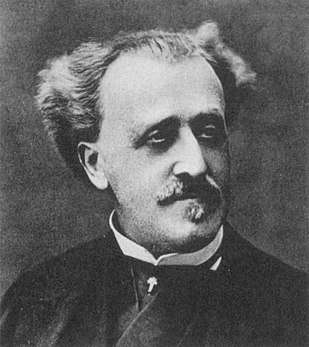 | |
| Born |
June 30, 1828 Lille, France |
| Died | January 9, 1909 (aged 80) |
| Resting place | Père Lachaise Cemetery, Paris |
| Nationality | French |
| Alma mater | University of Paris |
| Occupation | Physician |
| Children | Marguerite Gachet (1869-1949), Paul GHachet jr. (1873-1962) |
Paul-Ferdinand Gachet (30 July 1828 – 9 January 1909) was a French physician most famous for treating the painter Vincent van Gogh during his last weeks in Auvers-sur-Oise. Gachet was a great supporter of artists and the Impressionist movement. He was an amateur painter, signing his works "Paul van Ryssel", referring to his birthplace: Gachet came "from" (Dutch: "van") "Ryssel" (actually Rijssel) – the Dutch name of Lille.[1]
Biography
Born and raised in Lille, his family moved to Mechelen, where Gachet's father was transferred to in 1844/1845 to start a new branch of the firm he was working for.[2]
While a student at the University of Paris, he learnt drawing in his spare time, and collected paintings by Gustave Courbet and Édouard Manet.[3]. After gaining his BA degree, he worked at the mental hospitals of Bicêtre and Salpêtrière. His teachers included Armand Trousseau. In 1858 he received a medical degree for his thesis Étude sur la Mélancolie (Éditeur du Montpellier Médecal).
He returned to Paris and set up a private practice. In 1872 he moved to Auvers-sur-Oise, a town around 27 kilometres (17 mi) from the centre of the city that was popular with artists. There he continued his medical practice, but also associated with artists such as Camille Pissarro and Paul Cézanne, Cézanne helping him establish his own studio in his attic.[3]
Gachet also knew Gustave Courbet, Champfleury and Victor Hugo. He was a friend of the chemist Henri Nestlé and prescribed Nestlé's new powdered milk supplement to some of his child patients. Under the pen-name Blanche de Mézin, he published books in medicine and art-criticism.[4]
He spent much time with Charles Méryon after the etcher's committal to Charenton. He oversaw Auguste Renoir's recovery from pneumonia in 1882. He advised Édouard Manet against the amputation of his leg. However, Manet did not follow this advice.
Gachet's tomb is situated in section 52 of Père Lachaise Cemetery in Paris.[5]
Gachet and Vincent van Gogh
Vincent's brother, Theo van Gogh, thought that Gachet's background and sensitivity toward artists would make him an ideal doctor for Vincent during his recovery. Very soon after he began seeing Gachet, however, Vincent began to doubt the doctor's usefulness.[6] Vincent described Gachet as: "sicker than I am, I think, or shall we say just as much".
Gachet has come in for much criticism over the years regarding Van Gogh's suicide after ten weeks of consultation. However, Van Gogh was either unable or unwilling to follow his doctors' advice to cut back on alcohol and smoking. According to Arnold, "there was not much else available to any physician of the day which could have reversed the course of Vincent's illness,"[7] and he summarizes the medical treatment that Van Gogh received from his various doctors thus: "The overall assessment is rather that they did as well as expected with an unfamiliar disease and a difficult patient."[8]
Subject in art
Gachet was friends with and treated Pissarro, Renoir, Manet, Cézanne and Goeneutte, to name just a few. He had amassed one of the largest impressionist art collections in Europe before he died in 1909. Gachet, his wife and his home were the subjects of several pieces of art by celebrated artists including:[9]
 Portrait of Dr. Gachet, painting by Vincent van Gogh (1890), first version
Portrait of Dr. Gachet, painting by Vincent van Gogh (1890), first version.jpg) Dr. Gachet, etching by Vincent van Gogh (1890)
Dr. Gachet, etching by Vincent van Gogh (1890)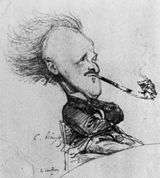 Paul Gachet by Charles Leandre (c. 1887)
Paul Gachet by Charles Leandre (c. 1887)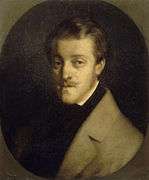 Paul Gachet by Ambroise Detrez (1850-1852)
Paul Gachet by Ambroise Detrez (1850-1852)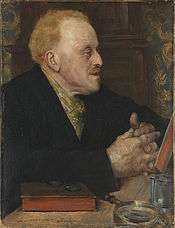 Paul Gachet, painting by Norbert Goeneutte (1891), Musée d'Orsay, Paris
Paul Gachet, painting by Norbert Goeneutte (1891), Musée d'Orsay, Paris Paul Gachet by Émile Bernard (1926 posthumous) Musée d'Orsay
Paul Gachet by Émile Bernard (1926 posthumous) Musée d'Orsay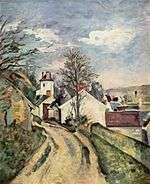 Paul Cézanne, The House of Doctor Gachet in Auvers (1872-1873) Musée d’Orsay
Paul Cézanne, The House of Doctor Gachet in Auvers (1872-1873) Musée d’Orsay
References

- ↑ Therefore, Gachet's son Paul-Louis signed Louis van Ryssel
- ↑ A vast chronology of Doctor Gachet's life compiled by his son, is supplied in Distel, Anne and Stein, Susan Alyson (1999) Cézanne to Van Gogh: The Collection of Doctor Gachet, Metropolitan Museum of Art, New York, ISBN 0-87099-903-6, pp. 273–288
- 1 2 Museyon, (1 July 2011). Art + Paris Impressionists & Post-Impressionists: The Ultimate Guide to Artists, Paintings and Places in Paris and Normandy. Museyon. pp. 251–. ISBN 978-1-938450-24-2.
- ↑ Henk Tromp (2010). A Real Van Gogh: How the Art World Struggles with Truth. Amsterdam University Press. pp. 257–258. ISBN 978-90-8964-176-2.
- ↑ "GACHET Paul Ferdinand (1828-1909)". Cimetières de France et d’ailleurs. Retrieved 15 September 2018.
- ↑ Letter "Letter from Vincent van Gogh to Theo van Gogh, Auvers-sur-Oise, 10 July 1890". Webexhibits.org.
- ↑ Arnold, Wilfred N. (1992) Vincent van Gogh: Chemicals, Crises, and Creativity, Birkhãuser, Boston, ISBN 0-8176-3616-1, p. 66
- ↑ Arnold, work cited, page 216. Arnold assumes his own diagnosis of acute intermittent porphyria
- ↑ "Who is Dr Gachet". Realfrance.wordpress.com.
External links
| Wikimedia Commons has media related to Paul Gachet. |
- (in French) Biographical note by Jacqueline Sonolet and Paul Gachet's works digitized by the BIUM (Bibliothèque interuniversitaire de médecine et d'odontologie, Paris), see its digital library Medic@.